Pig Portraits
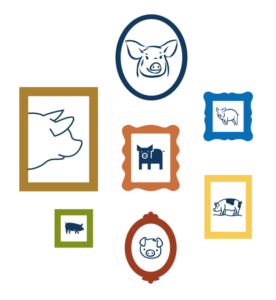 PFI farmers share their experience with different pig breeds and crosses.
PFI farmers share their experience with different pig breeds and crosses.
There’s an ongoing discussion in many livestock circles about the merits of one pig breed over another. Some farmers discount breed altogether, arguing that pig performance depends on whether individual animals can thrive in a given system. Is there an answer?
In true PFI style, the farmers featured here don’t claim to know what’s right. Rather, they share their experiences with raising pigs and what’s worked for them. Their approaches are diverse. But they have one thing in common: They’re all on team pig.
Ethan Book: Herefords
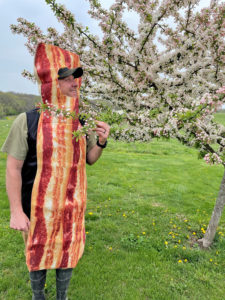 System: Wean-to-finish. Wooded pasture and deep bedded.
System: Wean-to-finish. Wooded pasture and deep bedded.
Reason for raising: The breed was developed in Iowa during the 1920s to be a hardy outdoor pig. “I’m a history guy, and an Iowa boy through and through.”
Stats: Average 125 pigs per year. Finish at 7-8 months.
Thoughts on Breeds: “I think a lot of times we get hung up on breeds. The most important thing is what can you get that’s profitable.”
Ethan Book and his family have been raising Herefords for 12 years at Crooked Gap Farm near Knoxville, Iowa. They raise about 100-125 pigs per year, mostly in wooded pasture but also in a deep-bedded hoop barn during the cold and muddy months. Their pigs finish in seven to eight months and are all directly marketed.
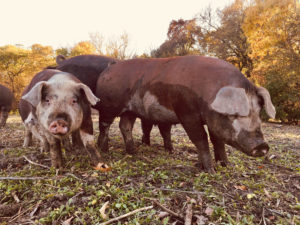 Ethan’s interest in Herefords, which were developed in Iowa in the 1920s, started while he was looking for a heritage breed to raise. “I’m a history guy, and an Iowa boy through and through, so that’s the great thing about them.” Another perk of Herefords, Ethan says, is that they were bred to be an all-purpose, hardy outdoor pig – traits that suit his production system.
Ethan’s interest in Herefords, which were developed in Iowa in the 1920s, started while he was looking for a heritage breed to raise. “I’m a history guy, and an Iowa boy through and through, so that’s the great thing about them.” Another perk of Herefords, Ethan says, is that they were bred to be an all-purpose, hardy outdoor pig – traits that suit his production system.
Ethan has capitalized on these traits to use the Hereford breed as a marketing tool. Even so, he says lots of other breeds could suit farmers’ needs. “Unless your marketing is really based around it, or there’s a specific reason you want that breed, there’s a lot of great pigs out there. Or a lot of great crosses!”
This perspective keeps him flexible. Despite his fondness for Herefords, he doesn’t mind bringing in other breeds as needed to maintain his pig herd size. “I think a lot of times we get hung up on a specific breed. The most important thing,” he says, “is what can you get that’s close by that can be profitable. Choose based on what you can get consistently and has the meat quality, mothering quality and outdoor hardiness that you’re looking for.”
Anna Hankins: Berkshires
System: Farrow-to-finish. Deep bedded and dry lots.
Reason for raising: Raised multiple breeds; Berkshires worked best in their system. They’re good mothers and have excellent meat quality.
Stats: Directly to consumers and restaurants. “[Berkshire pork] is highly marketable, like Angus Beef.”
Thoughts on Breeds: “Breed matters a lot. Different pigs raised the same way get different results.”
Anna Hankins and Shae Pesek raise farrow-to-finish Berkshire pigs at Over the Moon Farm near Coggon, Iowa, along with flowers and various other livestock species. For them, the Berkshire breed is a key part of their marketing strategy.
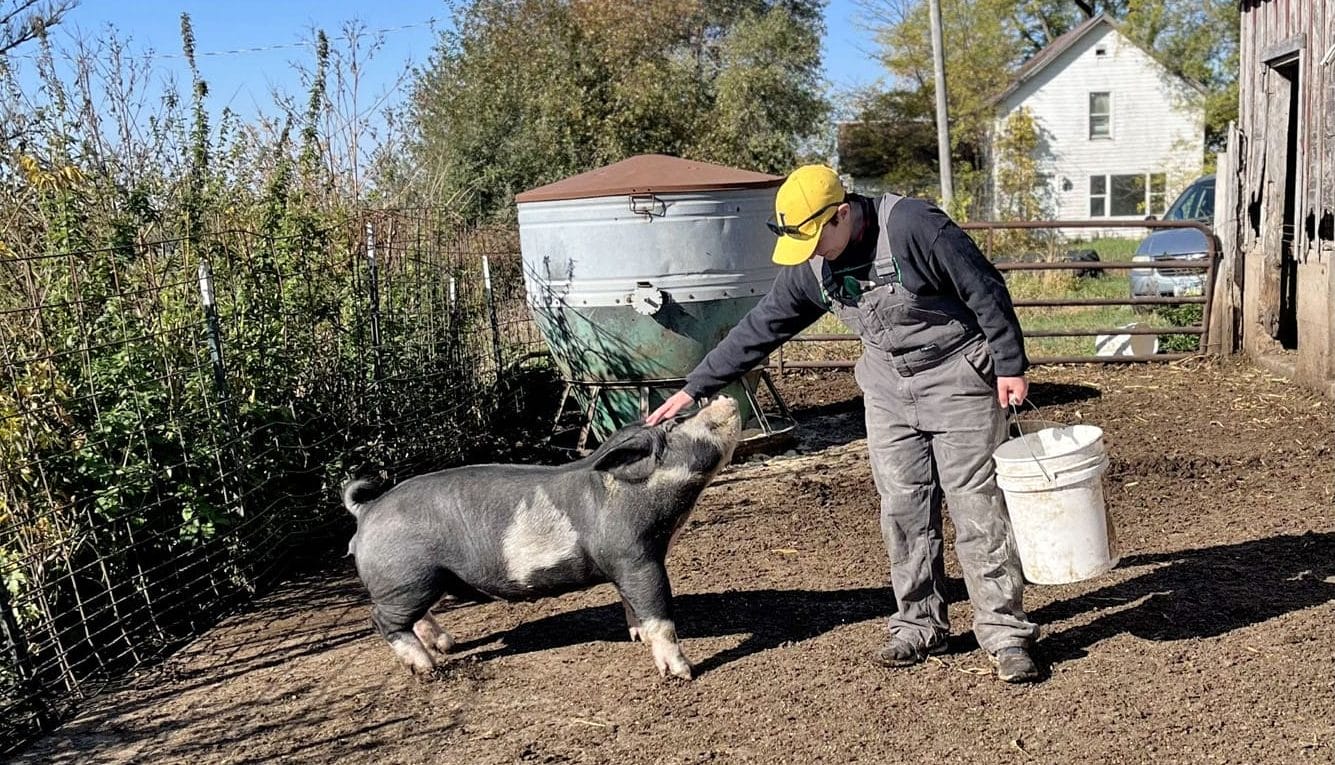 “There is something to be said about the name recognition, like Angus beef,” Anna says, referencing the successful marketing campaign of the Certified Angus Beef brand. “When you sell to a restaurant, they’re going to put on the menu that it’s Berkshire pork. It’s highly desirable and highly marketable for them. Even at farmers markets, I always label it as Berkshire pork and there are people who see that and say ‘Berkshire pork is so fancy and good, we’ve got to try it.’”
“There is something to be said about the name recognition, like Angus beef,” Anna says, referencing the successful marketing campaign of the Certified Angus Beef brand. “When you sell to a restaurant, they’re going to put on the menu that it’s Berkshire pork. It’s highly desirable and highly marketable for them. Even at farmers markets, I always label it as Berkshire pork and there are people who see that and say ‘Berkshire pork is so fancy and good, we’ve got to try it.’”
The duo didn’t start out with Berkshires. At first, they sought out any feeder pigs they could get. While these pigs were fine, Anna says they felt their pork, which they raise in a deep-bedded, dry-lot system, needed a more consistent look and taste. “There’s a big difference between breeds for what your meat actually looks like,” she says, “and that can be confusing for a customer base.”
Anna knows farmers debate whether breed or management has more influence on flavor and carcass quality. “My experience is that the breed matters a lot,” she says. “Those other factors matter too. But you can raise a mixed group of pigs all the same way, like we were doing, and get mixed results just because they’re not the same.”
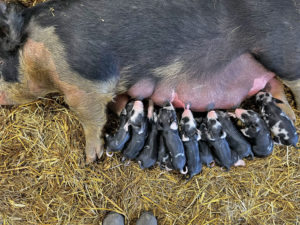 She and Shae eventually settled on Berkshires because they had raised a few and saw how adaptable the breed was. Shae’s father had also raised pigs in the 1970s and “had plenty of experiences with really mean sows,” Anna says. “So we knew we wanted pig breeds that were known for having a good temperament.” Other desirable attributes – such as good mothering instincts, big litters for a heritage breed (Berkshires average nine to 12 piglets) and taste – helped cement the switch.
She and Shae eventually settled on Berkshires because they had raised a few and saw how adaptable the breed was. Shae’s father had also raised pigs in the 1970s and “had plenty of experiences with really mean sows,” Anna says. “So we knew we wanted pig breeds that were known for having a good temperament.” Other desirable attributes – such as good mothering instincts, big litters for a heritage breed (Berkshires average nine to 12 piglets) and taste – helped cement the switch.
The couple now raise two groups of pigs a year, one farrowing in the spring and one in the fall. Pigs go to the processor roughly eight months later at 290 pounds.
Todd Maternach: Yorkshire-Landrace
System: Wean-to-finish. Conventional confinement.
Reason for raising: “When you’re selling to a packing plant, that’s all they want. We just try to please the packers.”
Stats: 40,000 pigs per year, finished in 6 months.
Piglet Source: Bought into a sow farm; partners with other farmers to determine genetic line.
Thoughts on Breeds: Landrace for larger litters. Yorkshires for good mothering. Duroc grows quickly and contributes to meat quality.
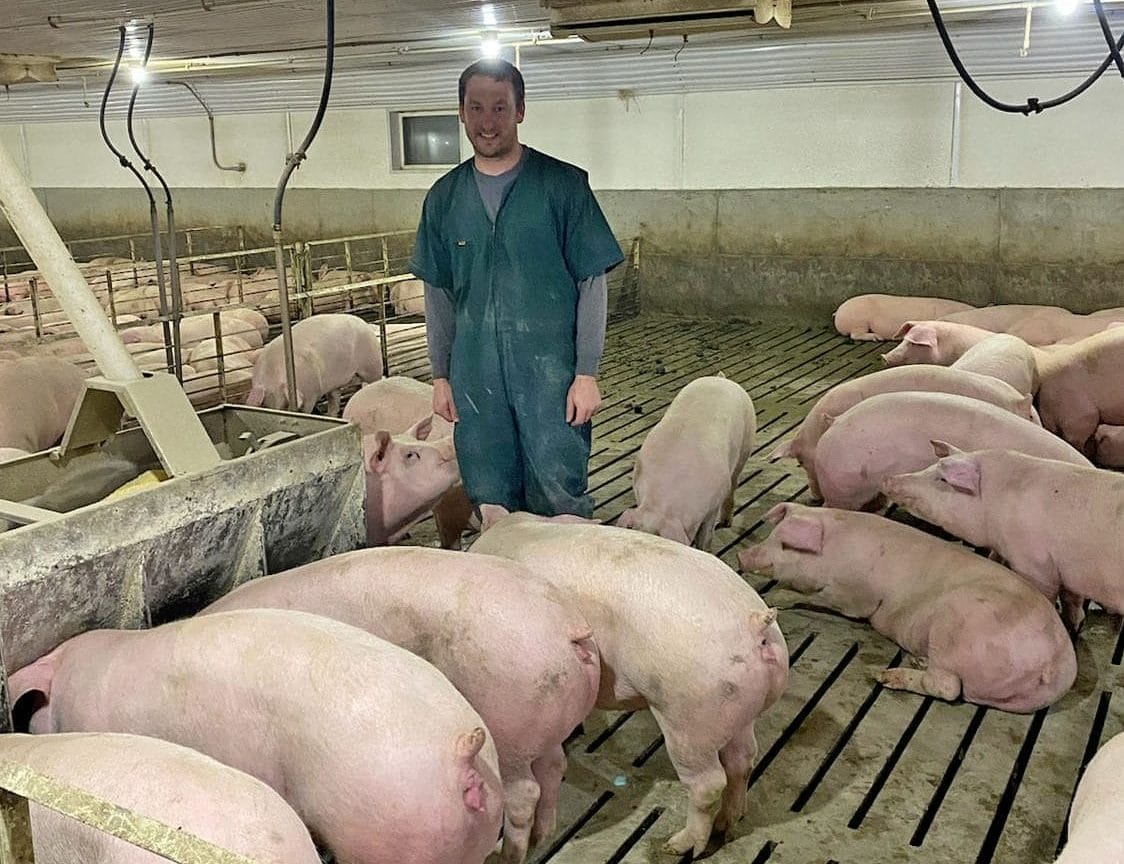 Todd Manterach grew up on his family farm outside of Cascade, Iowa, and has been raising pigs his whole life. For most of that time, his family raised pigs that came from Yorkshire-Landrace sows crossed with Duroc boars. “That’s pretty standard,” says Todd, who raises his pigs in a conventional pig confinement system. “When you’re selling to a packing plant, that’s all they want. And we just try to please the packers.”
Todd Manterach grew up on his family farm outside of Cascade, Iowa, and has been raising pigs his whole life. For most of that time, his family raised pigs that came from Yorkshire-Landrace sows crossed with Duroc boars. “That’s pretty standard,” says Todd, who raises his pigs in a conventional pig confinement system. “When you’re selling to a packing plant, that’s all they want. And we just try to please the packers.”
Today, the family operation includes Todd’s parents, three brothers and their families. “And Grandpa still helps out once in a while too,” he says. In the past, the Manternachs ran a farrow-to-finish operation. For increased efficiency, they now buy weaned pigs from a sow farm they’re part of. “When you’re in a sow farm, you’re in it with other farmers,” Todd says. “You come to an agreement on what genetic line you’d like within the given breeds.”
The Landrace produces larger litter sizes, he says. Yorkshires have good mothering abilities. And Durocs grow quickly and contribute to the meat quality. Todd raises 40,000 pigs a year in batches of 5,000. Weaned pigs arriving at Todd’s farm are 24 days old, weighing about 16 pounds. Around six months later, they’re sold to the packer at 280 pounds.
Laura Tidrick: Mangalitsas
System: Wean-to-finish. Pasture and deep-bedded.
Reason for raising: She grew up on a conventional hog farm and wanted pigs with self-reliant mothering instincts. “They’ll build a big nest and farrow from early spring all the way through late winter with really good results.”
Why this Cross: “Wonderful, super high-quality meat,” but too much lard for many customers. Large Blacks increase litter size. Tamworth, Hereford and Berkshire increase lean meat and finishing speed.
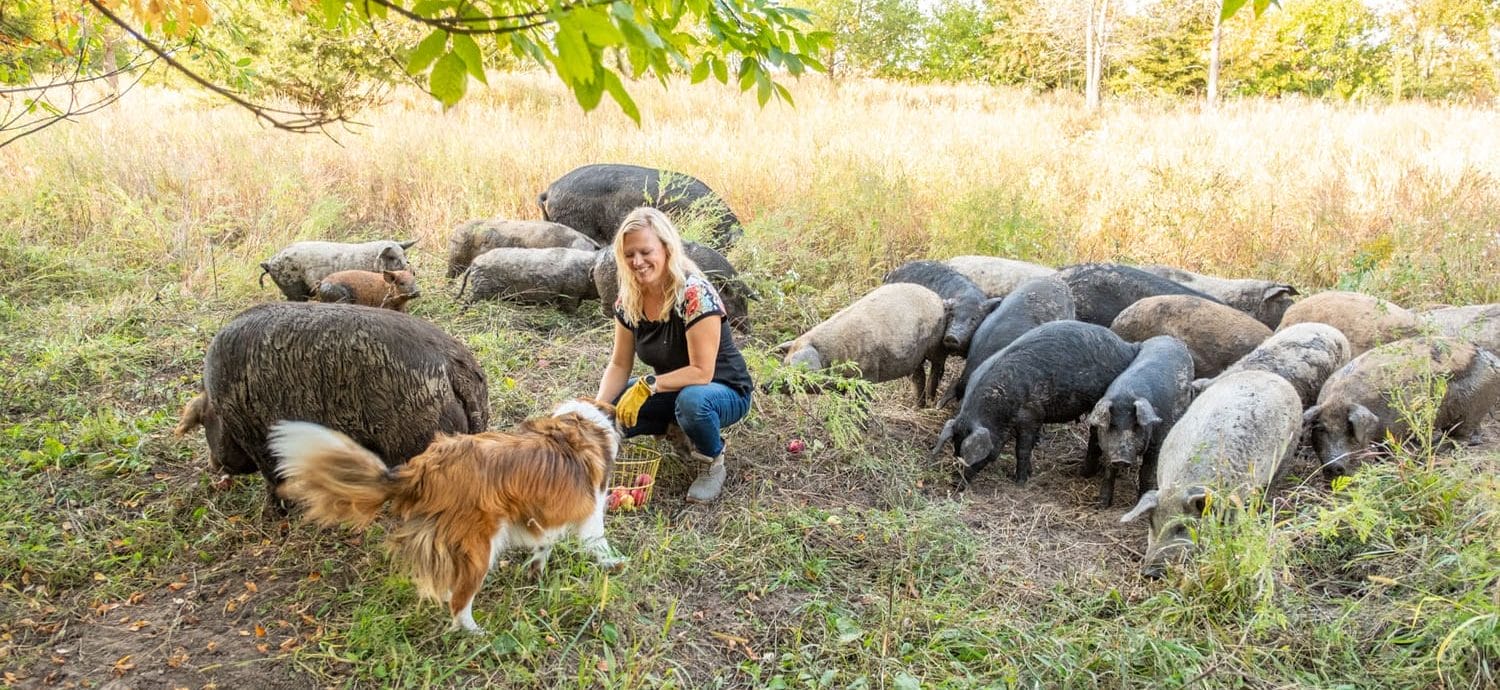 In contrast to Anna and Shae, Laura Tidrick started with a breed and moved to a cross. In 2015, she started raising purebred Mangalitsa pigs at Mossycup Farms near Clear Lake, Iowa. While she says they produce “wonderful, super high-quality meat,” they are a lard pig. Originally bred in Hungary for abundant, useful lard, the amount of lean meat from each animal was low.
In contrast to Anna and Shae, Laura Tidrick started with a breed and moved to a cross. In 2015, she started raising purebred Mangalitsa pigs at Mossycup Farms near Clear Lake, Iowa. While she says they produce “wonderful, super high-quality meat,” they are a lard pig. Originally bred in Hungary for abundant, useful lard, the amount of lean meat from each animal was low.
Growing up on a conventional hog confinement farm, Laura’s first job was in a farrowing barn pulling piglets. That was the motivation for a complete shift to find a pig with good mothering instincts that would thrive on pasture and deep bedding. “They’ll build a big nest and farrow from early spring all the way through late winter with really good results,” Laura says of the Mangalitsas. She adds that they’re “awesome mothers” and “really hardy animals” who need minimal care.
But the breed’s dearth of lean meat and relatively small litter size of six to eight piglets soon made it clear there was room for improvement. Laura first introduced Large Black genetics to increase the litter size. That boosted the number of piglets per sow by about three, and they produced more milk. But Large Blacks are also fatty, and each carcass yielded 40-50 pounds of pure lard. In response, Laura brought in Tamworth, Hereford and Berkshire pigs.
With the addition of these genetics, she now gets 15 pounds more lean meat per pig. She also finishes at eight months instead of a year with the purebred Mangalistas. Even with these changes, the direct and wholesale market remains niche. “It’s not what folks are used to from the grocery store – more marbling and fattier,” Laura says. “It’s not for everyone. But some people remember when pork used to be fattier, and this is perfect for them.” It also lets Laura make lard soap to sell as a value-added product.
For those starting out, Laura says, “If you want to make money, you’re much better off with a cross than a purebred. But I just love pigs. Even the ones I complain about are wonderful. If someone is considering an animal, hogs are a great animal to have.”
Read about Kevin and Kendra Martin’s experience raising Kune Kune pigs on their farm near Mount Ayr, Iowa, in this blog post.
